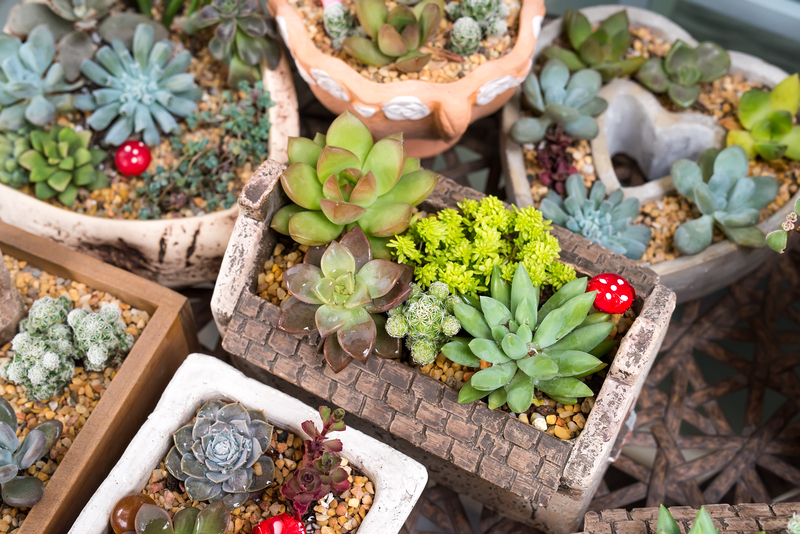A Gardener's Path to Herb Success
Posted on 22/08/2025
A Gardener's Path to Herb Success: Unlocking the Secrets of Herb Gardening
Herb gardening is an ancient yet ever-thriving tradition that offers immense satisfaction, utility, and beauty to any garden space. Whether you're a culinary enthusiast, a home gardener seeking natural remedies, or simply someone who loves the fragrance and aesthetics of green herbs, embarking on a gardener's path to herb success can transform your gardening experience. In this comprehensive article, we'll cover everything you need to know to cultivate a flourishing herb garden, from choosing the right herbs and prepping your soil to maintaining a thriving plot year after year.

Why Grow Herbs? The Enduring Appeal of an Herb Garden
Herb gardens are unique in their versatility and adaptability. Not only do they enhance the visual and aromatic allure of your garden, but they also serve practical purposes:
- Culinary delights: Fresh herbs like basil, mint, and parsley can elevate your dishes to new heights.
- Natural health: Herbs have long been used for their medicinal properties.
- Eco-friendly pest control: Many herbs naturally repel garden pests.
- Companion planting: Growing herbs alongside vegetables can improve yield and deter diseases.
- Well-being: Gardening promotes mental relaxation and mindfulness.
By following herb gardening tips and adopting best practices, you can ensure vibrant growth, bountiful harvests, and year-long enjoyment from your herb patch.
Planning for Herb Garden Success: Location & Design
Choosing the Right Spot
The foundation of successful herb gardening is selecting an optimal location. Most herbs require:
- Full sun: Aim for at least 6-8 hours of direct sunlight daily.
- Well-drained soil: Soggy roots are a common culprit for stunted herbs.
- Shelter from wind: While air circulation is vital, excessive wind can stress delicate herb plants.
If outdoor space is limited, container herb gardening or a windowsill herb garden can be just as rewarding. Pots on balconies or kitchens can offer convenience and beauty -- enabling urban dwellers to walk their own path to herb gardening success.
Designing Your Herb Garden
Herb gardens can be formal or informal, sprawling or compact. Consider these herb garden design ideas:
- Raised beds: Make soil management easy and improve drainage.
- Spiral herb gardens: Create visual interest while optimizing microclimates for sun-loving and shade-preferring herbs alike.
- Mixed borders: Integrate herbs with flowers or vegetables to attract pollinators and deter pests.
When planning, group herbs with similar water and sunlight needs to streamline care and boost your herb gardening success.
Soil Preparation: The Root of Herbal Health
Understanding Your Soil
Healthy soil is the most critical aspect of growing healthy herbs. Start with a simple soil test to check pH (most herbs prefer a neutral to slightly alkaline pH of 6.0-7.5) and nutrient levels. Amend the soil as needed to create optimal conditions.
Soil Enrichment Tips
- Compost: Adding organic matter improves fertility and drainage.
- Sand or grit: Enhance drainage for Mediterranean herbs like rosemary and lavender.
- Mulching: Helps retain moisture, suppress weeds, and maintain even soil temperatures.
A gardener's path to herb garden success starts with nurturing the earth from the ground up.
Selecting the Best Herbs for Your Garden
Best Culinary Herbs
- Basil
- Parsley
- Cilantro (Coriander)
- Chives
- Rosemary
- Thyme
- Oregano
- Dill
- Sage
- Mint (plant in pots to control spread)
Herbs for Health and Wellness
- Lavender (for calm and sleep)
- Chamomile (digestive and calming tea)
- Lemon balm (soothing reliever)
- Echinacea (immune booster)
When choosing your herbs, consider plant hardiness zones, climate, and personal needs. Experimenting with a variety ensures a rewarding and diverse herb gardening journey.
Starting Your Herb Garden: Seeds vs. Seedlings
Growing Herbs from Seed
Sowing seeds is cost-effective and offers a broad selection of herb varieties. However, some herbs, like parsley and rosemary, can be slow to germinate.
- Start indoors early: Use seed trays and controlled temperatures for best results.
- Provide gentle moisture: Mist gently to avoid disturbing tiny seeds.
Using Seedlings or Transplants
For quicker results, consider planting herb seedlings from a nursery. Hardy herbs like basil, thyme, and oregano transplant well and provide a head start for new gardeners.
Direct Sowing vs. Indoor Sowing
- Direct sow: For easy-grow herbs like dill, cilantro, or chervil, sow directly after the last frost.
- Indoor sowing: Start tender herbs indoors 6-8 weeks before final frost, then harden off before transplant.
Plant spacing, soil moisture, and protection from pests are crucial elements in herb gardening success.
Watering, Feeding, and Maintenance: Key Steps for Healthy Herbs
Proper Watering Techniques
- Avoid overwatering: Most herbs prefer evenly moist, not waterlogged, soil.
- Morning watering: Reduces evaporation and discourages fungal diseases.
- Mulch: Retain moisture and suppress weeds with organic mulch, particularly around tender seedlings.
Fertilizing & Feeding Herbs
- Minimal feeding: Herbs often develop better flavor in slightly lean soils.
- Organic compost: Top-dress with mature compost twice a year for slow-release nutrition.
- Avoid high-nitrogen fertilizers: Too much nitrogen promotes lush growth but dilutes aroma and flavor.
Pruning and Harvesting for Success
- Regular harvesting: Pinching or snipping encourages bushier growth and prolongs life.
- Remove flowers: For most culinary herbs, pinch off flower buds to prevent bolting and loss of flavor.
Consistent, moderate care is the secret to a thriving herb garden that produces flavorful, healthy plants all season long.
Troubleshooting: Pests, Diseases, and Common Problems in Herb Gardens
Natural Pest Management
Many herbs naturally deter pests thanks to their aromatic oils. Still, vigilance is necessary:
- Aphids and whiteflies: Use insecticidal soap or a firm spray of water.
- Slugs and snails: Handpick at dusk or use organic slug pellets.
- Spider mites: Increase humidity and use targeted miticides if necessary.
Combating Diseases
- Fungal infections: Avoid overhead watering and give plants enough space for air circulation.
- Root rot: Ensure fast-draining soil and avoid waterlogged conditions.
- Mildew: Remove affected leaves and consider a milk spray as a natural treatment.
Healthy soil, proper spacing, and moderate watering are your best defenses against disease on your herb gardening journey.
Harvesting and Preserving Your Herbs
How and When to Harvest
The key to maximizing both yield and flavor is timing your herb harvest:
- Harvest before flowering: Much of an herb's essential oils and flavors peak just before it blooms.
- Morning cuts: Pick after dew dries but before lunch for the most potent aroma and flavor.
- Use clean scissors: Always use sharp, sanitized tools to prevent disease spread.
Preserving Your Herbal Harvest
- Drying: Tie small bunches and hang upside down in a dark, dry, well-ventilated room.
- Freezing: Chop and freeze herbs in ice cube trays with water or oil for fresh flavor year-round.
- Infusions and vinegars: Infuse oils or vinegars with fresh herbs to capture flavor for months to come.
By preserving your herbs, you extend the pleasures of the growing season--one of the great joys on the path to herb gardening success!

Expanding Your Herb Garden: Advanced Tips & Companion Planting
Companion Planting for a Thriving Herb Bed
- Basil with tomatoes: Basil repels tomato hornworms and enhances fruit flavor.
- Chives with carrots: Chives deter carrot flies and promote growth.
- Cilantro near spinach: Repels aphids for both crops.
Integrating herbs with vegetables and flowers not only saves space, it creates a balanced, biodiverse ecosystem--an essential step for experienced gardeners looking to take herb gardening to the next level.
Propagating Herbs for Cost Savings
- Cuttings: Many perennial herbs (rosemary, sage, mint) root easily in water or moist soil.
- Division: Split mature plants like chives and oregano every few years to boost productivity.
- Layering: Bend a stem to soil, cover with dirt, and snip off new rooted growth after a few weeks.
Sharing cuttings or divisions with friends or neighbors fosters a sense of community--underlining why growing and sharing herbs has always been a treasured element of gardening culture.
Conclusion: Embark on Your Path to Herb Gardening Success Today
Whether you're just starting out or seeking to refine your skills, cultivating a thriving herb garden is a joy accessible to all. By understanding your growing conditions, choosing the right varieties, caring for your soil, and employing sustainable, natural practices, your journey on a gardener's path to herb success will reward you with beauty, culinary delights, and well-being for years to come.
So gather your tools, select your seeds, and let the aroma of fresh herbs guide you to gardening triumph. This is your season--embrace the gardener's journey to herb success!

